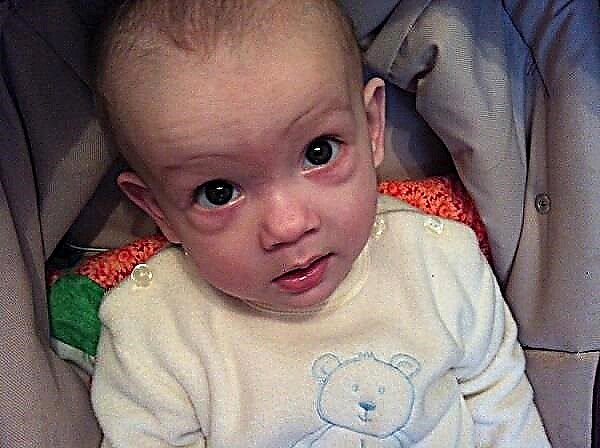In order to introduce porridge into a child's complementary foods, attention and caution are required. New products are given in sequence. The introduction of porridge into complementary foods has a positive effect on the development of the baby, enriches his body with nutrients and vitamins.

Porridge for baby
The benefits of porridge for child nutrition
It is difficult to imagine a healthier product in a child's diet. Cereal porridges are a storehouse of trace elements and vitamins necessary for the full development of the baby. This dish should be on the table every day. Only in this case will the child grow up strong and healthy.
Here is a rating of the most useful cereals for babies:
- Oatmeal. It contains a lot of phosphorus, iron, magnesium, potassium. It is a source of vegetable fats and fiber.
Note! You can enter this porridge into the menu only after the child reaches one year old.
- Millet. Rich in B vitamins, as well as iron, magnesium, fluorine and copper. It contains the entire set of essential amino acids. The composition contains substances that can remove radionuclides from the body. Porridge is also suitable for weakened children. They introduce it to the menu from the age of one and a half.
- Barley. Contains vitamins and a large amount of trace elements important for growth, among them phosphorus, iron, iodine, cobalt and chromium. Contains proteins and complex carbohydrates. Has the ability to remove poisons from the body and reduce the manifestation of food allergies.
- Buckwheat. Rich in B vitamins, iron, potassium, calcium and phosphorus. More useful is the so-called green buckwheat. Provides a boost of energy for the whole day.
- Children's doctors recommend starting complementary foods with rice. It has a pronounced enveloping effect and is quickly digested. To benefit from it, you should add dried fruits, fruits and pumpkin.
- Corn porridge is rich in fiber, starch, easy to digest.
Nutritional value
Any porridge contains proteins, fats and carbohydrates. The calorie content of these dishes varies depending on the type of cereal (in kcal per 100 g of the finished dish):
- buckwheat - 101;
- oatmeal - 109;
- pearl barley - 135;
- wheat - 153;
- millet - 109;
- rice - 144;
- barley - 98.
How to choose the right cereal
Choose cereals for baby porridge very carefully. The benefits and taste of the finished product depend on its quality. Packaged cereals are somewhat more expensive than bulk cereals. You should opt for a product by weight. Its quality can be assessed visually. The quality of purchased cereals can be found only in the kitchen.
When choosing buckwheat groats, you should pay attention to its following characteristics:
- Colour. The lighter it is, the less it has been processed and, therefore, more useful.
- Manufacturer. It is not recommended to buy small Chinese buckwheat.
- It is best to buy premium cereals.
- It should not contain a lot of impurities.

Quality buckwheat
High-quality millet groats should not shine (shine means that the grain is fodder). Round grain rice is suitable for milk porridge for children. When choosing it, you need to pay attention to the purity of the grains and their transparency.
Important! Matte rice may become sticky after cooking.
When choosing oatmeal, you need to pay attention to its color. Quality flakes have a gray-yellow tint. Groats "Hercules" are healthier, although they take longer to cook. The benefits of extra oatmeal will be less.
Where to start
Parents are interested in what kind of porridge is best for the first feeding. At the very beginning, you should make gluten-free cereals for the first complementary foods: rice, corn and buckwheat (including from Nestlé). They rarely cause allergic reactions and are gluten free. In addition, it is advisable to give the child a dairy-free product for the first time. This is because cow's milk protein can cause allergies in some children.
At the beginning of complementary feeding, it is recommended to give the child mono-component cereals - they are easier to digest. According to Dr. Komarovsky, sugar, salt and fruit additives must not be added to them. He believes that if you introduce them into complementary foods, the child will have intestinal upset.
The child's health depends on what kind of porridge to introduce first into complementary foods and how much to give it. Therefore, the ideal option would be rice or buckwheat porridge.
Entry sequence
An approximate sequence of croup is as follows:
- rice (buckwheat or corn) - 6-7 months;
- oatmeal - 8 months;

Oatmeal for baby
- pearl barley, millet - 9-10 months;
- semolina - after a year or two.
Porridge with fruit additives are recommended from the age of seven months.
What cereals should not be administered
You cannot enter gluten cereals into the baby's diet: wheat, semolina, barley, etc. They should diversify the child's menu after a year. It is advisable to give semolina only after two years of age.
Note! Until one year old, you should not give your child porridge with cow's milk, even if it is gluten-free. In general, dairy dishes are a huge burden for the digestive system of a baby.
When can you give porridge
It is recommended to introduce it into complementary foods from the age of six months.
How to cook porridge correctly
There are several ways to cook a dish. If cereal flour is used, then before boiling the porridge, it should be diluted in cold water, and then add boiling milk or mixture. Then you need to boil for 5 minutes.
When preparing a cereal dish, first boil the porridge, then add hot milk to it and cook until tender. Rub the finished dish through a sieve with your hands.
The features of cooking some cereals are as follows:
- Buckwheat - cooked for 15 minutes. For 5 g of cereal, take 100 ml of water, add a few tablespoons of freshly prepared milk mixture.
- Boil rice for 10 minutes. For 20 g of cereals - 50 g of water or breast milk.
- Cooking time for corn porridge is half an hour. For 100 ml of water, you should take 5 g of cereals.
Norms of complementary feeding with porridge by month
The rules for introducing cereals into complementary foods are the same as for vegetable puree. In order for the baby to quickly get used to the new product, first you need to cook the so-called five percent porridge. For 100 ml of water take 5 g of cereals. You need to cook this dish in water.
The first time a child is given a teaspoon of 5% porridge. Within a week or 10 days, this volume is brought to 150 g, that is, to a portion of a full feeding. If the dish is well tolerated, then they switch to 10% porridge.
It is best to spoon-feed complementary foods for breakfast. If the baby is breastfed, then after complementary feeding it must be attached to the breast. At the stage of the child's getting used to the new dish, butter should be added to the porridge.
You should adhere to this order of feeding when introducing porridge:
- monitor the child's reaction to the tolerance of cereals;
- replace cow's milk with a mixture;
- introduce all new products into the diet gradually;
- for the development of teeth and jaws, it is necessary for the porridge to be thick.
What can be combined with
Porridge goes well with milk, fruits and dried fruits, vegetables, butter.

Rice with fruit
How often to give
These dishes should be on the child's menu every day.
Number
With artificial feeding, the amount of formula should be such that the volume of all food reaches 200 ml. This means that if a child has eaten 100 ml of porridge, he needs to be given the same amount of mixture. After 9 months, the child should be given 200 ml of the dish. This means completely replacing one feeding with milk or formula.
Nutritional Problems with Complementary Feeding
When complementary foods, the child may develop diarrhea or constipation. Often - the development of intestinal colic associated with excess gas production.
Important! Rice has a fixing effect. If you give too much of it, your child may develop constipation.
Signs of allergies
If you give a baby gluten porridge, he may develop allergies. This often happens when he is bottle-fed. The reaction may appear several hours after feeding, or may be delayed for days or even weeks. Symptoms of a gluten allergy are:
- a small rash on the skin (similar to hives);
- diarrhea;
- severe bloating;
- loss of appetite;
- the baby does not sleep well;
- he becomes irritable and whiny.
If, during the feeding with cereals, the child began to gain weight poorly, swelling of the limbs appeared, then it is likely that the child has a genetic gluten intolerance - celiac disease. It leads to a breakdown of the entire digestive system.

Manifestation of allergies
Complementary cereals are of great benefit to the child's body. It is advisable to feed them from the age of six months. Some of them are introduced only after the baby reaches one year old. Knowing which porridge to start with will help prevent feeding problems.



